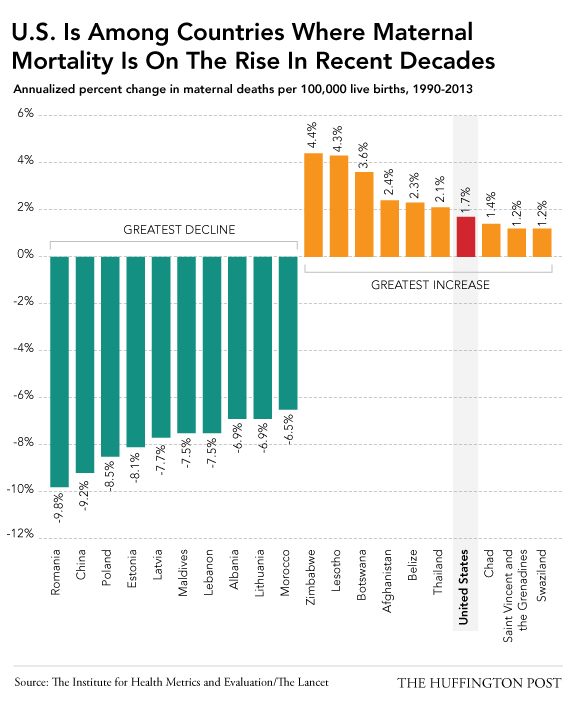
The pregnancy-related death rate in Texas nearly doubled between 2010 and 2012 ― the same time period that the state severely cut women’s health funding, most notably at Planned Parenthood, according to a new study.
The research, which will be published in the September issue of the journal Obstetrics and Gynecology, found that 148 Texas women died in 2012 from pregnancy-related causes, either while pregnant, or soon after being pregnant, up from 72 deaths in 2010. Similarly, the rate in Texas jumped from 18 deaths per 100,000 births in 2006 to 36 deaths per 100,000 births in 2014.
But sadly, Texas is just an extreme snapshot of the United States’ bigger maternal mortality problem.
The U.S. is the only developed country in the world where maternal deaths actually increased between 1993 and 2013, according to the World Health Organization.
While 99 percent of maternal deaths happen in developing countries, the U.S. shoulders a disproportionate burden for a developed nation. Other countries where maternal mortality increased during that same time period included Afghanistan, Botswana and Chad.

A constellation of systemic health care failures
“There is sadly no magic bullet that explains what is behind the high levels of maternal mortality in the United States,” Rachel Ward, managing director of research at Amnesty International U.S., previously told Al Jazeera. “It’s a combination of factors that speak to the systemic problems of failing to provide affordable, accessible, quality health services to all women in the United States.”
Some Americans are more vulnerable than others; race and poverty play roles. Poverty is tightly linked to poor health outcomes, including depression, asthma, obesity and diabetes, all of which are more prevalent in poor communities than in the general population, and which are considered pregnancy risk factors by the National Institutes of Health. Poor women are also less likely to have access to health care, contraception and prenatal care, all of which can contribute to poor health outcomes.
And for pregnant women of color, there are added ― and largely unexplained ― risks. A study published in the American Journal of Public Health in 2007 found that although black women were no more likely than white women to suffer from dangerous pregnancy-related conditions such as preeclampsia, eclampsia, abruptio placentae, placenta previa, and postpartum hemorrhage, they were two to three times more likely to die from those conditions than their white counterparts.
What happened in Texas is hard to explain
The study authors felt that closing women’s health services in Texas wasn’t a dramatic enough occurrence to explain the maternal mortality spike.
“In the absence of war, natural disaster, or severe economic upheaval, the doubling of a mortality rate within a 2-year period in a state with almost 400,000 annual births seems unlikely,” they wrote.
And yet, the mortality rate did double. The study authors didn’t speculate about what could have caused this spike in maternal deaths, and a state task force tasked to study the problem in 2013 won’t release its first report until Sept. 1.
Still, access to care is a major issue, especially for women in rural areas. According to Sarah Wheat, a spokeswoman for Planned Parenthood of Greater Texas, closing family planning clinics hurt women in Texas, many of whom see the clinics as an entry point into the health care system, the Dallas Morning News reported.
“Chances are they’re going to have a harder time finding somewhere to go to get that first appointment,” Wheat said. “They may be delayed in getting that initial pregnancy test and then a prenatal referral.”
But abortion access is key for maternal health
Another important factor in maternal mortality, one that’s less frequently discussed, is women’s access to safe and legal abortion.
Making it difficult for women to have abortions doesn’t mean abortions don’t happen. Instead, women who don’t have legal access take risks, either by attempting dangerous self-abortions or by trusting individuals without formal training to perform the procedure in sometimes less than hygienic conditions.
Unsafe abortions are one of the three leading causes of maternal mortality, along with hemorrhage and sepsis from childbirth, according to the Guttmacher Institute. They also account for between 8 and 15 percent of maternal mortality deaths in developing nations, according to a report published in BJOG: An International Journal of Obstetrics & Gynecology in 2015.
And with abortion clinics rapidly closing in Texas, this is a major concern. Between 2012 and 2015, the number of abortions clinics in Texas shrank from 41 to 17, which puts the average Texas county approximately 111 miles its nearest clinic, according to The New York Times.
CORRECTION: A previous version of this article stated that unsafe abortions are the leading cause of maternal mortality worldwide. In reality, hemorrhage is the leading cause.
